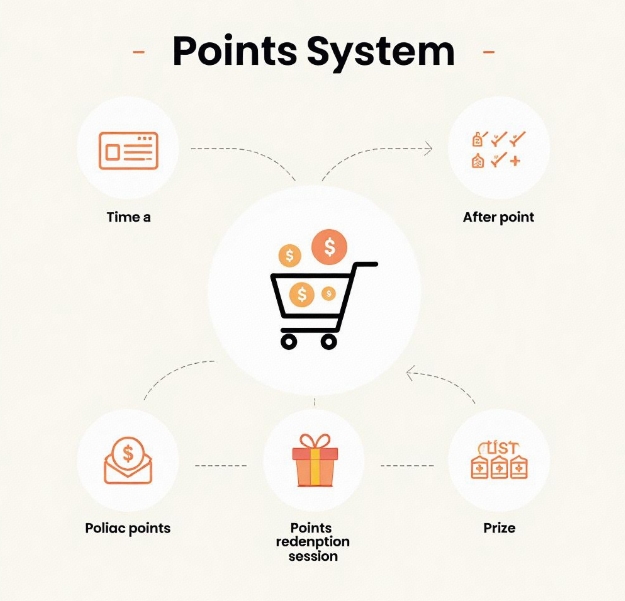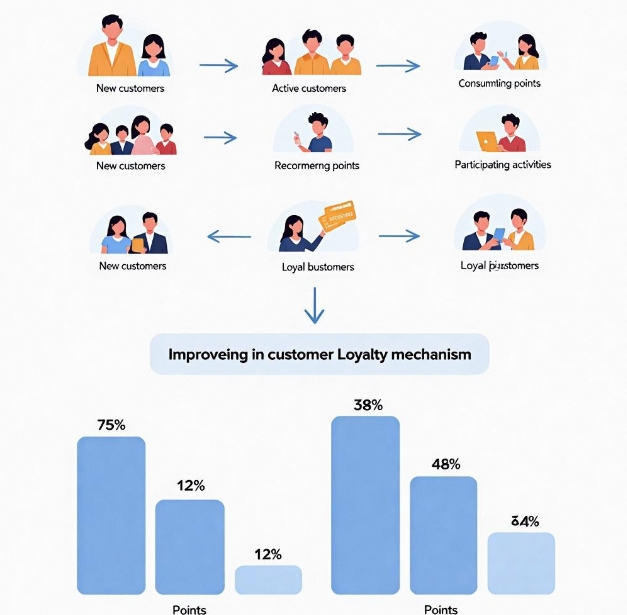How Can an Integral Mall Empower Brand Loyalty Programs? Case Analysis
- latest articles
- 1.DApp Development & Customization: Merging Diverse Market Needs with User Experience 2.Analysis of the Core Technical System in DApp Project Development 3.How to achieve cross-chain interoperability in Web3 projects? 4.How does the tokenization of points reconstruct the e-commerce ecosystem? 5.How to Set and Track Data Metrics for a Points Mall? 6.What is DApp Development? Core Concepts and Technical Analysis 7.Inventory of commonly used Web3 development tools and usage tips 8.Development of a Distribution System Integrated with Social E-commerce 9.Six Key Steps for Businesses to Build a Points Mall System 10.What is DApp Development? A Comprehensive Guide from Concept to Implementation
- Popular Articles
- 1.Future Trends and Technology Predictions for APP Development in 2025 2.Analysis of the DeFi Ecosystem: How Developers Can Participate in Decentralized Finance Innovation 3.From Zero to One: How PI Mall Revolutionizes the Traditional E-commerce Model 4.DAPP Development | Best Practices for Professional Customization and Rapid Launch 5.Recommended by the Web3 developer community: the most noteworthy forums and resources 6.How to Develop a Successful Douyin Mini Program: Technical Architecture and Best Practices 7.From Cloud Computing to Computing Power Leasing: Building a Flexible and Scalable Computing Resource Platform 8.Shared Bike System APP: The Convenient Choice in the Era of Smart Travel 9.How to Create a Successful Dating App: From Needs Analysis to User Experience Design 10.From Design to Development: The Complete Process of Bringing an APP Idea to Life
In the modern business environment, brand loyalty programs have become important tools for companies to enhance customer retention, increase repurchase rates, and drive long-term revenue. As an innovative tool, points malls are increasingly becoming a vital component of brand loyalty programs. Through points malls, brands can not only effectively incentivize customer engagement but also deepen customers' identification with and loyalty to the brand, thereby achieving long-term brand development goals.
This article will explore how points malls empower brand loyalty programs, analyze their principles and advantages, and through several practical case studies, demonstrate how points malls perform excellently across different industries and brands.
I. Definition and Role of Points Malls
1.1 Definition of Points Malls
A points mall, as the name suggests, is a reward mechanism based on points. Consumers accumulate points by purchasing goods, participating in activities, etc., and can redeem these points for various products or services in the mall. A points mall is not just a simple redemption platform; it encourages more interaction between consumers and the brand through its reward mechanism, thereby enhancing customer loyalty and sense of participation.
1.2 Role of Points Malls
The empowerment of points malls for brand loyalty programs is mainly reflected in the following aspects:
Enhance Customer Stickiness: Through the incentive mechanism of points, customers are encouraged to frequently participate in brand activities and purchase products, increasing the frequency of interaction between customers and the brand.
Increase Repurchase Rate: Points malls provide customers with redeemable rewards. Customers often choose to continue purchasing to earn more points for desired items, thereby increasing the brand's repurchase rate.
Strengthen Customer Loyalty: When customers feel the brand's rewards and recognition, they develop a stronger sense of identity and belonging, ultimately forming long-term loyalty.
Precise Data Analysis: Through the use of points malls, brands can accumulate a large amount of data on customer behavior, enabling precise marketing and personalized recommendations to improve marketing effectiveness.
II. Principles of How Points Malls Empower Brand Loyalty Programs
The core principle by which points malls empower brand loyalty programs is through reward mechanisms and enhanced customer engagement, stimulating consumers' continuous attention to the brand and their desire to consume. Specifically, the empowerment of points malls for brand loyalty programs relies mainly on the following principles:
2.1 Reward Mechanism Principle
A points mall is essentially a mechanism based on behavioral rewards. Consumers accumulate points through actions like purchasing goods and participating in activities, which can then be exchanged for various rewards. Through continuous participation, consumers gradually earn rewards and develop a psychological expectation for more, creating motivation for ongoing engagement in brand activities. Brands use this mechanism to provide positive reinforcement for customer behavior.
2.2 Building a Sense of Participation and Belonging
Points malls enhance the interaction between consumers and the brand by providing opportunities to redeem products. During participation, consumers not only receive tangible rewards but, more importantly, build emotional identification and a sense of belonging to the brand through continuous engagement and point accumulation. This emotional connection helps the brand maintain long-term customer loyalty.
2.3 Data-Driven Personalized Marketing
By collecting and analyzing data on customer purchasing behavior and preferences, points malls assist brands in personalized marketing. Brands can tailor exclusive reward schemes or push personalized offers based on individual customers' point status, increasing customer engagement and purchase intent.
III. Advantages of Points Malls in Empowering Brand Loyalty Programs
The advantages of points malls in empowering brand loyalty programs are multifaceted, including the following key points:
3.1 Enhancing Customer Engagement
Points malls encourage customers to participate multiple times in brand activities by establishing various ways to earn points, thereby increasing customer activity. For example, customers can earn points not only by purchasing goods but also through social sharing, product reviews, and other methods. Such diversified participation methods make it easier for customers to accumulate points, thus increasing overall customer engagement.
3.2 Strengthening Interaction Between Brand and Customers
Points malls enable more frequent and rich interactions between the brand and its customers. By setting up activities like point redemption and point lotteries, brands can continuously stimulate customers' interest in participation and desire to purchase. Additionally, brands can build closer connections with customers through points malls, such as sending personalized services like birthday greetings and holiday wishes via the mall, further enhancing customers' favorability and loyalty towards the brand.
3.3 Promoting Repurchases and Cross-Selling
Points malls can effectively promote customer repurchases. When customers accumulate a certain number of points, they typically have a desire to redeem them, leading them to purchase the brand's products again to earn more points, thereby boosting the brand's repurchase rate. Furthermore, brands can use points malls for cross-selling, such as recommending related products or services during point redemption, further increasing sales.
3.4 Facilitating Customer Data Collection and Analysis
The use of points malls helps brands collect customer purchasing data, preference data, etc., enabling precise market positioning and personalized marketing. Through data analysis, brands can understand which products are most popular among customers, customers' purchase cycles, spending levels, etc., thereby optimizing product recommendations, adjusting inventory, and formulating more targeted marketing strategies.
IV. Case Studies: Application of Points Malls in Brand Loyalty Programs
4.1 Case Study 1: Starbucks Membership Points Program
Starbucks is a classic example of applying points malls in brand loyalty programs. Starbucks' "Starbucks Rewards" membership system uses a points mall approach to enhance customer loyalty. Consumers earn points when purchasing coffee at Starbucks through their payment method, and these points can be redeemed later for various rewards, such as free drinks and exclusive discounts. Starbucks also offers different exclusive benefits based on members' spending tiers. This differentiated points reward system enhances consumers' sense of participation.
Through this points mall program, Starbucks has not only successfully attracted a large number of loyal customers but also uses member data analysis for precise marketing. For example, Starbucks pushes personalized coupons or new product tasting events based on members' purchasing habits, allowing customers to experience more personalized care, thereby increasing the brand's customer stickiness and loyalty.
4.2 Case Study 2: JD.com's JD PLUS Membership Points Mall
JD.com's "JD PLUS Membership" program is another successful case of using a points mall to enhance brand loyalty. By providing a points mall for members, JD.com allows consumers to earn points through purchasing goods or participating in activities. Points can be redeemed for various products or used for exclusive discounts. Members can also receive different levels of membership benefits through the points mall, such as birthday coupons, exclusive customer service, and early access to sales.
The JD PLUS Membership program achieves precise customer targeting and marketing through the points mall. Through data analysis, JD.com can understand each member's shopping habits and push targeted coupons, promotional events, or customized product recommendations, increasing member activity and repurchase rates. Additionally, JD.com uses the interactivity of the points mall to strengthen communication and connection with consumers, enhancing long-term brand loyalty.
4.3 Case Study 3: Taobao's Points Reward System
Taobao also uses a points mall to incentivize user participation in its brand loyalty program. Taobao's "Taoci Value" system rewards active users with points. Users earn Taoci Value by shopping on Taobao, reviewing products, participating in interactions, etc. These points can not only be used to participate in Taobao's promotional activities but also enhance the user's credibility level on the platform, granting more privileges.
Through the points mall, Taobao incentivizes users to make more purchases and interactions, increasing platform activity. Simultaneously, the Taoci Value system provides Taobao with a wealth of user behavior data, aiding the platform in personalized recommendations and precise marketing.
V. Conclusion
As a crucial tool in brand loyalty programs, points malls can enhance customer engagement and brand loyalty through reward mechanisms, data analysis, and personalized services. Analysis of practical cases shows that points malls not only increase customer repurchase rates and promote interaction between the brand and customers but also provide brands with precise data support to optimize marketing strategies.
As business competition intensifies, the application of points malls will become increasingly widespread, serving as an important means for brands to build long-term customer loyalty and enhance market competitiveness. Brands should fully leverage the advantages of points malls, design loyalty programs that fit their unique characteristics, and ultimately achieve sustained growth and success.
-

How does the tokenization of points reconstruct the e-commerce ecosystem?
With the continuous advancement of internet technology and the gradual prolifera···
-

How to Set and Track Data Metrics for a Points Mall?
With the rapid development of the e-commerce industry, points malls, as a common···
-

Development of a Distribution System Integrated with Social E-commerce
With the rapid development of internet technology, the e-commerce industry has e···

 Blockchain
Blockchain












